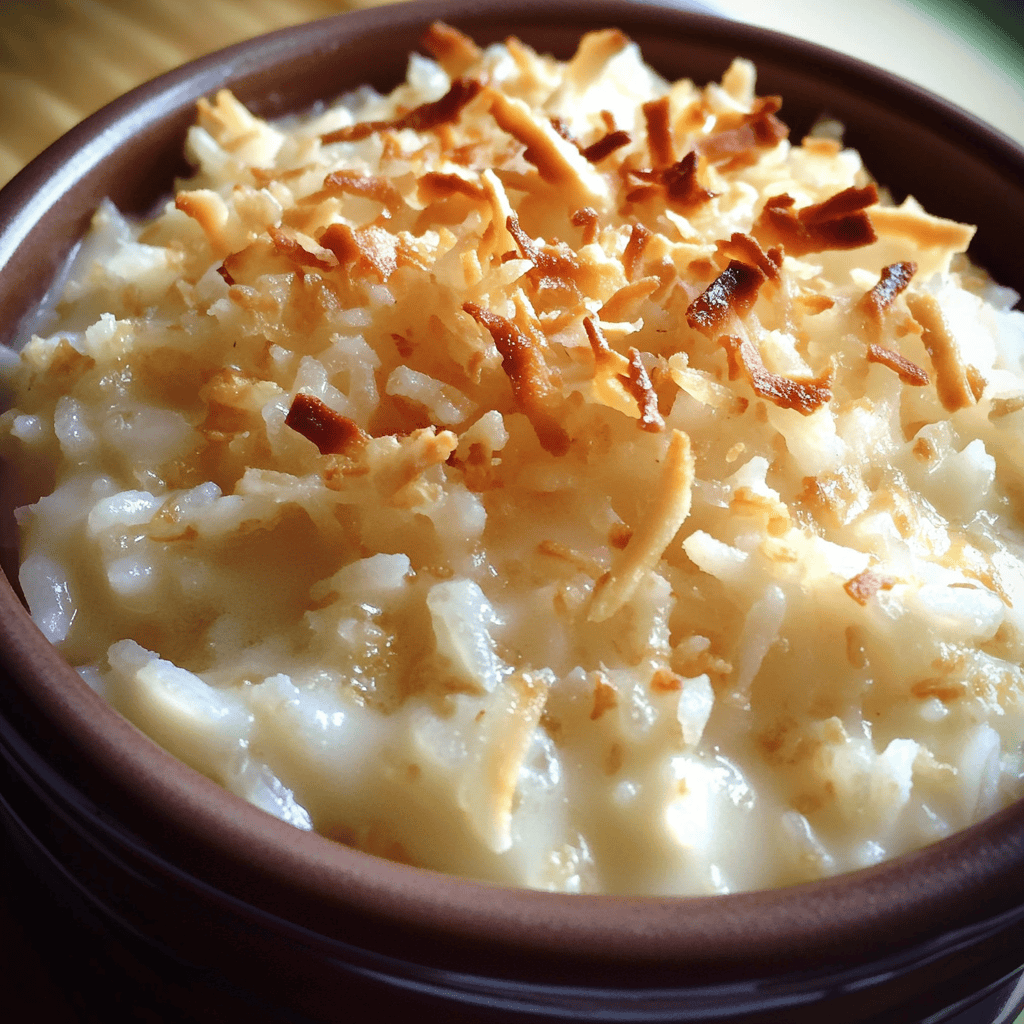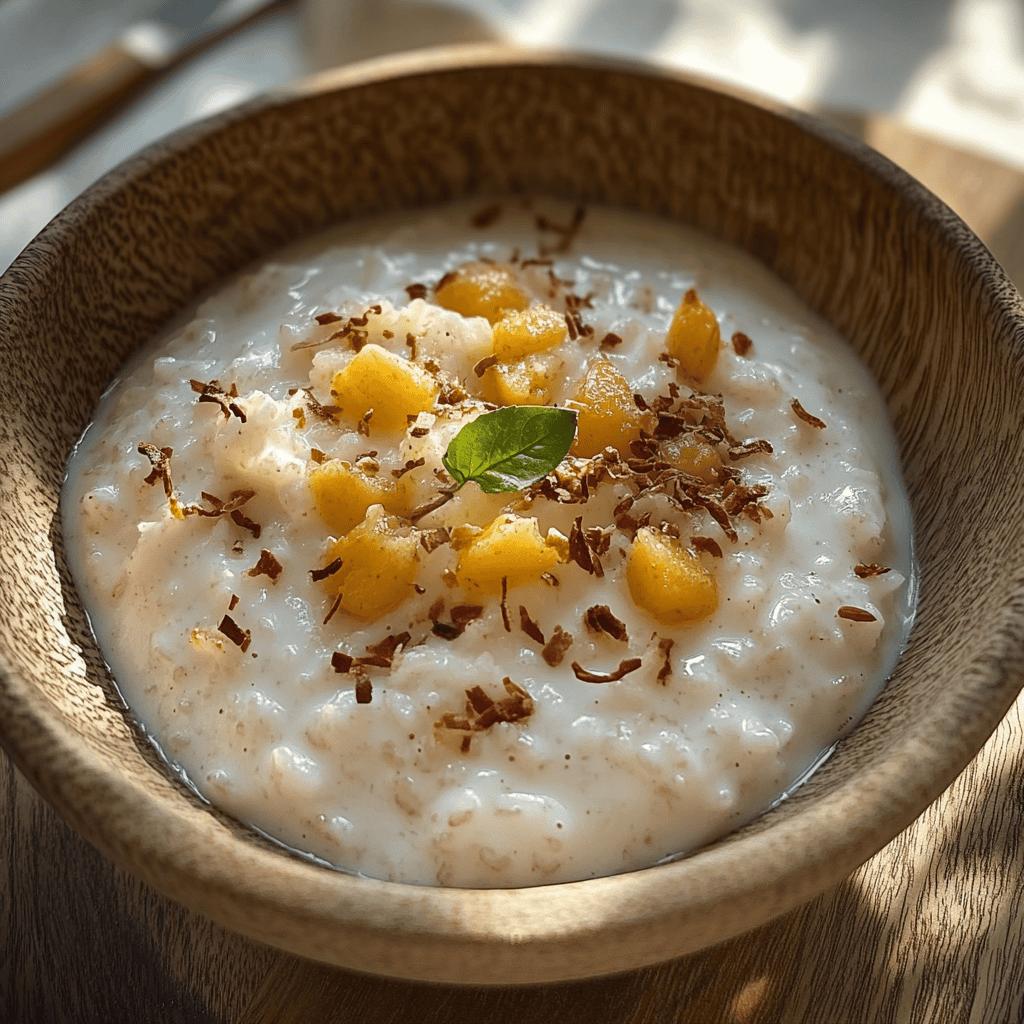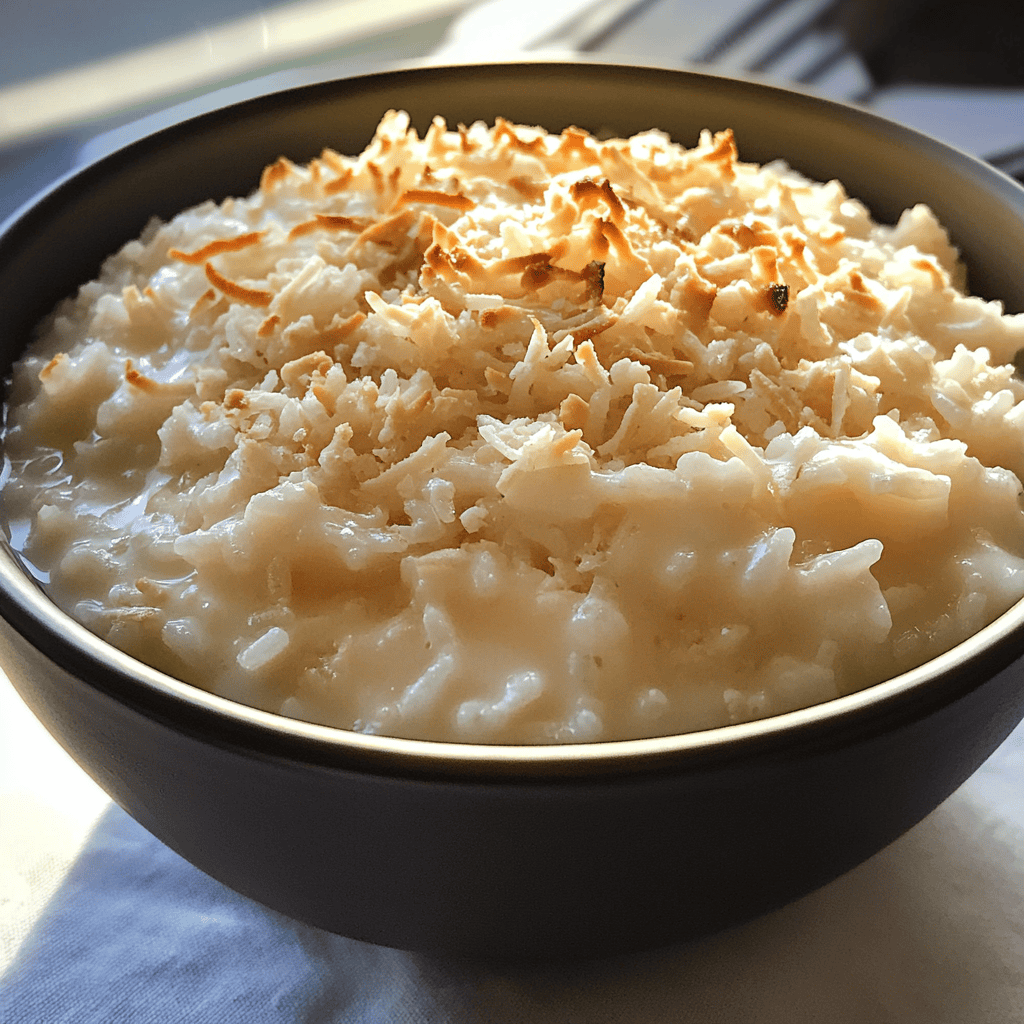Quick Overview
Coconut Rice Pudding is a delightful dessert that brings a taste of the tropics right to your kitchen. This comforting dish combines the creaminess of coconut milk with the chewy texture of rice, creating an indulgent treat that everyone will love. Whether you’re serving it as a sweet ending to a family meal or enjoying it on its own as a snack, this recipe is both simple and satisfying. The warm aroma of coconut fills your home as you prepare this dish, making it not only delicious but also inviting.
This Coconut Rice Pudding recipe requires minimal ingredients and can be made in just under an hour. It’s perfect for those who want to whip up something special without spending all day in the kitchen. With its rich flavor and smooth texture, it’s sure to become a favorite for anyone who tries it. Plus, you can easily customize it by adding fruits or spices to suit your taste. Get ready to impress your friends and family with this easy yet delectable dessert.
Ingredient Breakdown
Rice
Rice serves as the base of this Coconut Rice Pudding. Long-grain white rice works best due to its ability to absorb flavors while remaining tender. For this recipe, you’ll need one cup of uncooked long-grain white rice. Rinse the rice thoroughly before cooking; this removes excess starch and prevents the pudding from becoming too sticky.
Coconut Milk
Coconut milk is what gives this dish its rich and creamy consistency. You’ll need two cans (13.5 ounces each) of full-fat coconut milk for optimal flavor and richness. Using full-fat coconut milk ensures that your pudding remains silky smooth and has a decadent taste. If you prefer a lighter version, you can opt for light coconut milk.
Sugar
To sweeten your Coconut Rice Pudding, use half a cup of granulated sugar. Sugar not only adds sweetness but also helps balance the creaminess of the coconut milk. You can adjust the sugar amount based on your personal preference or dietary needs; alternatives like honey or agave syrup work well too.
Salt
Adding a pinch of salt enhances all the flavors in your pudding without making it salty. Use about one-fourth teaspoon of salt to bring out the sweetness naturally found in the coconut and sugar.
Vanilla Extract
Vanilla extract adds depth to the flavor profile of your Coconut Rice Pudding. Use one teaspoon for a subtle yet fragrant touch that complements the other ingredients beautifully.
Step By Step Recipe: Coconut Rice Pudding
Step 1: Cook the Rice
Start by rinsing one cup of long-grain white rice under cold water until the water runs clear. This step helps remove excess starch from the rice which can lead to clumping later on. In a medium saucepan, combine the rinsed rice with two cups of water and half a teaspoon of salt over medium heat. Bring it to a boil then reduce the heat to low, cover, and let it simmer for about 15 minutes or until all water is absorbed. Once done, remove from heat and let it sit covered for another 10 minutes; this resting period allows the grains to fluff up perfectly.
Step 2: Prepare Coconut Mixture
While waiting for your rice to finish cooking, grab another pot and pour in two cans (13.5 ounces each) of full-fat coconut milk along with half a cup of granulated sugar and one teaspoon of vanilla extract. Stir these ingredients together over medium heat until they are well combined; keep an eye on it so that it doesn’t come to a boil—just warm enough for melting sugar completely into the mixture will do fine! After about five minutes on low heat, add in your cooked rice from earlier into this creamy blend and stir gently but thoroughly until every grain is coated evenly with that luscious coconut goodness.
Step 3: Thicken Your Pudding
To achieve that perfect consistency for your Coconut Rice Pudding, continue cooking on low heat while stirring occasionally over approximately 20 minutes—or until it reaches your desired thickness! As you stir gently during this time frame, you’ll notice how beautifully thickened everything gets together as liquid evaporates slowly away leaving behind velvety smoothness enveloping those delightful grains! If you wish for added richness or creaminess at this point—feel free adding additional splashes more within those limits based upon individual preferences!
Step 4: Cool And Serve
Once you’ve achieved your desired thickness in step three above—it’s time finally serve up! Remove from heat carefully before transferring into serving dishes like bowls or small cups; allow them cool significantly enough before garnishing if preferred (consider fresh fruit slices such as mangoes/pineapples/coconut flakes etc.). For those wanting chilled versions instead—refrigerate them around hour before digging in! Enjoy each spoonful filled with heavenly textures bursting forth from every bite!
Serving and Storing Tips
Serving Suggestions
Coconut Rice Pudding tastes fantastic on its own but experimenting with toppings makes it all even better! Consider serving each portion topped off with fresh mango slices or toasted shredded coconut flakes sprinkled generously across top surface area—this adds both visual appeal alongside extra layers deliciousness enhancing overall experience further! Another delightful idea includes drizzling small amounts honey/maple syrup across puddings yielding sweetness levels customizable according personal preferences when indulging after meals too!
Storing Leftovers
If you happen to have any leftovers after enjoying this sumptuous dessert—don’t worry! Storing properly will keep flavors intact longer ensuring nothing goes wasted unnecessarily either way! To store effectively place cooled portions into airtight containers fitting snugly inside refrigerator where they’ll stay fresh up five days max; make sure seal tightly between servings prevent moisture loss ruining texture quality later down line when ready enjoy again!
Reheating Instructions
When reheating leftover Coconut Rice Pudding—it’s important maintain creamy texture throughout warming process so ideally avoid microwave unless absolutely necessary since often leads dryness issues arising afterward instead utilize stovetop method instead! Simply transfer desired amount onto saucepan heating gradually low flame while stirring frequently until heated through evenly maintaining original lusciousness intact till reaching comfortable temperature just right savor every last bite without losing any wonderful qualities initially experienced first round served!
By following these guidelines carefully throughout preparation journey towards creating incredible dish—you’ll find joy sharing delightful experiences around table whenever occasion arises needing satisfyingly sweet end note highlight events shared among loved ones alike!
Mistakes to avoid
When making Coconut Rice Pudding, a few common mistakes can lead to disappointing results. One primary mistake is using the wrong type of rice. Short-grain rice, such as arborio or sticky rice, is ideal for this dish due to its high starch content. Long-grain varieties like basmati or jasmine may not yield the creamy texture you desire. Always check your rice type before starting.
Another mistake involves cooking time. Overcooking the rice can result in mushiness, while undercooking leaves it hard and chewy. Aim for a balance; simmer the rice until tender but still slightly firm. The pudding should thicken naturally as it cools.
Using low-quality coconut milk is another misstep. Opt for full-fat coconut milk for richness and flavor. Avoid canned versions that contain additives or preservatives, as these can alter the taste and texture of your pudding.
Not letting the pudding sit after cooking can also affect its consistency. Allowing it to rest for at least 30 minutes lets flavors meld and it thickens further, enhancing the overall experience.
Lastly, neglecting proper seasoning can lead to blandness. A pinch of salt balances sweetness, while adding a touch of vanilla or sugar enhances depth. Always taste your pudding before serving to ensure a well-rounded flavor profile.
Tips and tricks
To master Coconut Rice Pudding, consider some useful tips and tricks that guarantee success. Start by rinsing the rice thoroughly to remove excess starch. This step prevents clumping and ensures each grain remains distinct while still achieving creaminess.
Cooking on low heat is crucial for even distribution of warmth. High heat may cause the mixture to scorch or bubble over, ruining your pudding’s texture and flavor. Stir frequently to prevent sticking; this technique also helps release more starch from the rice into the pudding.
Incorporating spices can elevate your dish significantly. Adding cinnamon sticks or cardamom pods during cooking infuses delightful flavors into the pudding without overpowering it. Remove these spices before serving to avoid any unpleasant surprises.
For an added twist, consider experimenting with toppings such as fresh fruit or toasted coconut flakes. These additions not only enhance presentation but also introduce new textures and flavors that complement the creamy base.
Lastly, always store leftover Coconut Rice Pudding properly in an airtight container in the fridge. It can last up to three days, but be aware that it may thicken as it cools. To serve again, simply reheat gently with a splash of coconut milk for a smooth consistency.
Suggestions for Coconut Rice Pudding
When preparing Coconut Rice Pudding, there are several suggestions that can help you create an unforgettable dessert experience. First, consider using fragrant pandan leaves during cooking for a unique aroma and subtle flavor enhancement. Just tie them into a knot and simmer them with your rice; remove them before serving.
You might also try varying sweetness levels based on personal preference or dietary needs. Experiment with different sweeteners like honey or maple syrup instead of traditional sugar. Each alternative brings its unique flavor profile without sacrificing quality.
Pairing your Coconut Rice Pudding with additional elements can transform it into an exquisite dish. For instance, serving it alongside mango slices creates a delightful contrast between creamy texture and juicy fruitiness—a perfect combination!
If you want to add crunch to your dessert, top it with roasted nuts like almonds or cashews just before serving. Their nuttiness enhances the overall flavor while providing a satisfying textural difference against soft pudding.
Lastly, when presenting Coconut Rice Pudding at gatherings or special occasions, consider using elegant serving dishes paired with garnishes such as mint leaves or edible flowers for visual appeal—this small touch makes all the difference in impressing guests!
FAQs
What ingredients do I need for Coconut Rice Pudding?
To make delicious Coconut Rice Pudding, you’ll need just a few essential ingredients: short-grain rice (like arborio), full-fat coconut milk, water, sugar (or another sweetener), and salt for balance. You can enhance flavors by incorporating vanilla extract or spices such as cinnamon or cardamom if desired.
How long does it take to cook Coconut Rice Pudding?
Cooking Coconut Rice Pudding typically takes about 30-40 minutes from start to finish depending on multiple factors like heat level and specific recipe variations used during preparation; however patience pays off! Allow sufficient time for simmering until both rice is tender while achieving desired creamy consistency without rushing through any steps along way!
Can I make Coconut Rice Pudding dairy-free?
Yes! One of the great features of this recipe is that it’s naturally dairy-free due to using coconut milk instead of cow’s milk which often contains lactose intolerances issues present in many individuals today! Ensure all other ingredients are also free from dairy products such as butter when preparing this dish.
How should I store leftovers?
Leftover Coconut Rice Pudding should be stored in an airtight container placed within refrigerator after cooling down completely so that moisture doesn’t escape leading towards spoilage over time—properly stored leftovers last around three days! If desired enjoy warm again by reheating gently along with splash more coconut milk added back into mix restoring creamy texture once again!
Can I freeze Coconut Rice Pudding?
Freezing Coconut Rice Pudding isn’t recommended because its texture may change upon thawing resulting in separation where creaminess disappears leaving behind an unappealing dessert experience overall; however if needed simply store leftovers properly within refrigerator instead enjoying fresh taste every time served!
What can I serve with Coconut Rice Pudding?
Coconut Rice Pudding pairs beautifully with various accompaniments! Fresh fruits like mangoes provide delightful contrasts between sweetness & acidity; roasted nuts add crunch while enhancing flavors alongside creamy base—other options include drizzling honey/maple syrup over top creating extra indulgence throughout dessert presentation itself!
Summary
In summary, mastering Coconut Rice Pudding requires careful attention to detail in preparation methods along with ingredient choices leading towards delectable dessert outcomes everyone loves! Avoid common mistakes such as using improper rice types or cooking too long ensuring perfectly tender yet creamy results instead while also remembering sweetening adjustments tailored towards individual preferences make all difference too!
Implement tips including rinsing rice thoroughly prior cooking & utilizing low heat will help maintain proper consistency throughout process alongside infusing spices elevating overall flavor profiles enjoyed immensely by guests alike when served elegantly presented garnished appropriately too! Storing correctly afterwards ensures leftovers remain fresh up-to-three days giving opportunity savor delightful treat repeatedly any time desired thereafter!




